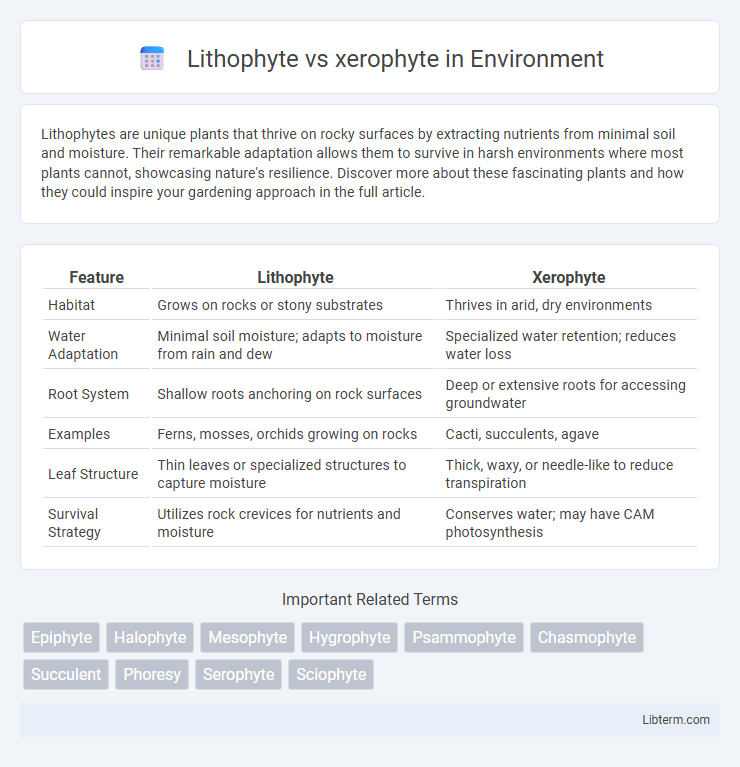Lithophytes are unique plants that thrive on rocky surfaces by extracting nutrients from minimal soil and moisture. Their remarkable adaptation allows them to survive in harsh environments where most plants cannot, showcasing nature's resilience. Discover more about these fascinating plants and how they could inspire your gardening approach in the full article.
Table of Comparison
| Feature | Lithophyte | Xerophyte |
|---|---|---|
| Habitat | Grows on rocks or stony substrates | Thrives in arid, dry environments |
| Water Adaptation | Minimal soil moisture; adapts to moisture from rain and dew | Specialized water retention; reduces water loss |
| Root System | Shallow roots anchoring on rock surfaces | Deep or extensive roots for accessing groundwater |
| Examples | Ferns, mosses, orchids growing on rocks | Cacti, succulents, agave |
| Leaf Structure | Thin leaves or specialized structures to capture moisture | Thick, waxy, or needle-like to reduce transpiration |
| Survival Strategy | Utilizes rock crevices for nutrients and moisture | Conserves water; may have CAM photosynthesis |
Introduction to Lithophytes and Xerophytes
Lithophytes are plants adapted to grow on rocky surfaces, deriving nutrients from minimal soil or organic matter, often found in environments with limited water retention. Xerophytes are specialized plants thriving in arid conditions with adaptations such as thick cuticles, reduced leaf areas, and deep root systems to minimize water loss and maximize water uptake. Both plant types exhibit unique morphological and physiological traits to survive in extreme habitats with limited water availability.
Defining Lithophytes: Key Features
Lithophytes are plants adapted to grow on rocky surfaces, obtaining nutrients primarily from rainwater, decaying organic matter, and atmospheric deposits. They possess specialized root systems that anchor securely in crevices and absorb moisture efficiently in nutrient-poor environments. Unlike xerophytes, which are adapted to survive in arid climates by conserving water, lithophytes focus on thriving in minimal soil conditions on rocks and cliffs.
Understanding Xerophytes: Main Characteristics
Xerophytes are plants adapted to survive in environments with limited water availability, such as deserts and arid regions. They exhibit key characteristics including thick, waxy cuticles to reduce water loss, deep or widespread root systems for efficient water absorption, and specialized leaves like spines or reduced leaf surface area to minimize transpiration. These adaptations enable xerophytes to maintain hydration and metabolic function under extreme drought conditions.
Habitat Differences: Rocks vs. Arid Environments
Lithophytes thrive predominantly on rocks and rocky substrates in diverse environments, extracting nutrients from minimal soil and organic matter trapped in crevices. Xerophytes are adapted to arid environments with scarce water availability, possessing specialized structures to minimize water loss and survive extreme drought conditions. The distinct habitats influence their physiological adaptations, with lithophytes optimized for nutrient-poor rocky surfaces and xerophytes designed for moisture retention in dry climates.
Adaptations for Survival in Extreme Conditions
Lithophytes adapt to extreme conditions by anchoring to rocks and extracting nutrients from minimal soil or organic matter, developing specialized root systems for water retention and nutrient absorption. Xerophytes exhibit adaptations such as thickened cuticles, reduced leaf surface area, and extensive root networks to minimize water loss and maximize water uptake in arid environments. Both plant types employ physiological mechanisms like CAM photosynthesis or water storage tissues to enhance survival under limited water availability.
Water Conservation Strategies
Lithophytes conserve water by growing on rocks with minimal soil, utilizing efficient water absorption mechanisms and reduced transpiration to survive in nutrient-poor, dry environments. Xerophytes exhibit specialized adaptations such as thick cuticles, sunken stomata, and extensive root systems to minimize water loss and maximize water uptake in arid conditions. Both plant types demonstrate unique morphological and physiological strategies to optimize water retention and maintain cellular hydration under water-limited habitats.
Morphological Distinctions
Lithophytes exhibit specialized root structures adapted for anchoring to rocky substrates and extracting nutrients from minimal soil or crevices, often possessing thick, leathery leaves to reduce water loss. Xerophytes display morphological adaptations such as reduced leaf size or spines, thick cuticles, and extensive water storage tissues to conserve moisture in arid environments. These distinct structural features enable lithophytes and xerophytes to thrive in their respective habitats by optimizing resource acquisition and water retention.
Ecological Roles and Importance
Lithophytes play a crucial ecological role by colonizing rocky substrates and contributing to soil formation through organic matter accumulation, supporting diverse microhabitats. Xerophytes are vital in arid ecosystems, enhancing water retention and preventing desertification by stabilizing soils and providing habitat for drought-adapted fauna. Both plant types facilitate nutrient cycling and promote biodiversity in their specialized environments, making them essential for ecosystem resilience.
Examples of Lithophyte and Xerophyte Species
Lithophyte species such as Saxifraga cotyledon and Orchis mascula thrive on rocky surfaces by extracting nutrients from minimal soil and organic matter. Xerophyte plants like cacti (e.g., Carnegiea gigantea) and succulents (e.g., Aloe vera) adapt to arid environments through water storage and reduced leaf surfaces. Both plant types exhibit specialized adaptations for survival in extreme habitats: lithophytes on nutrient-poor rocks and xerophytes in drought-prone regions.
Lithophytes vs. Xerophytes: Key Differences Summarized
Lithophytes thrive on rocky substrates, extracting nutrients from minimal soil particles and often relying on rainwater, while xerophytes adapt to arid environments with thick cuticles and deep root systems for water conservation. Lithophytes exhibit specialized root systems for anchorage on rocks, contrasting with xerophytes' adaptations like reduced leaf surface area to minimize transpiration. Both plant types demonstrate unique survival strategies but differ fundamentally in habitat preference and physiological mechanisms for nutrient and water uptake.
Lithophyte Infographic

 libterm.com
libterm.com